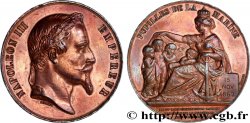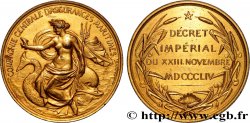fme_1019369 - SECOND EMPIRE Médaille, Rosière de la Brède
150.00 €
Количество
Добавить в корзину

Тип Médaille, Rosière de la Brède
Дата: 1865
Монетный двор / Город: 33 - La Brède
Металл: silver
Диаметр: 48 mm
Ориентация осей монеты: 12 h.
Гравер BARRE Albert Désiré (1818-1878)
Вес: 37,73 g.
Век: lisse + abeille ARGENT
Пуансон: abeille ARGENT
Комментарии о состоянии
Patine hétérogène avec des traces de rayures et coups. Points d’oxydation. Traces de nettoyage. Coups sur la tranche
Ссылки в каталоге: :
Лицевая сторона
Аверс: легенда: NAPOLÉON III - EMPEREUR.
Аверс: описание: Tête laurée de Napoléon III à droite. Signé : BARRE.
Обратная сторона
Реверс: легенда: FETES DE LA ROZIERE DE LA BREDE - AGEE DE 18 ANS // LE 26 JUIN 1865 / - / MARIA DEJEAN .
Реверс: Описание: Légende circulaire et en 5 lignes horizontales dans une fine couronne de chêne.
Комментарий
Médaille décernée à Maria Déjean en 1865 et avec un diamètre sans bélière de 41 mm.
La fête de la Rosière a été instaurée par François de Paule Latapie pour rendre hommage à l’illustre philosophe brédois : Montesquieu. Elle met à l’honneur une jeune fille de 18 ans, élue par ses pairs, mais aussi son rosier et ses anciens camarades de classe qui forment le cortège. Pendant 3 jours de festivité, cet événement emblématique rassemble toutes les générations. La première Rosière, Anne-Mélanie Giraudeau, fût élue en 1824.
Medal awarded to Maria Déjean in 1865 and with a diameter of 41 mm without bail. The Rosière Festival was established by François de Paule Latapie to pay tribute to the illustrious philosopher from Brédois: Montesquieu. It honors an 18-year-old girl, elected by her peers, but also her rosebush and her former classmates who form the procession. During 3 days of festivities, this emblematic event brings together all generations. The first Rosière, Anne-Mélanie Giraudeau, was elected in 1824
La fête de la Rosière a été instaurée par François de Paule Latapie pour rendre hommage à l’illustre philosophe brédois : Montesquieu. Elle met à l’honneur une jeune fille de 18 ans, élue par ses pairs, mais aussi son rosier et ses anciens camarades de classe qui forment le cortège. Pendant 3 jours de festivité, cet événement emblématique rassemble toutes les générations. La première Rosière, Anne-Mélanie Giraudeau, fût élue en 1824.
Medal awarded to Maria Déjean in 1865 and with a diameter of 41 mm without bail. The Rosière Festival was established by François de Paule Latapie to pay tribute to the illustrious philosopher from Brédois: Montesquieu. It honors an 18-year-old girl, elected by her peers, but also her rosebush and her former classmates who form the procession. During 3 days of festivities, this emblematic event brings together all generations. The first Rosière, Anne-Mélanie Giraudeau, was elected in 1824








 Cообщить об ошибке
Cообщить об ошибке Распечатать страницу
Распечатать страницу Отправить мой выбор
Отправить мой выбор Задать вопрос
Задать вопрос Consign / sell
Consign / sell
 Информация
Информация









